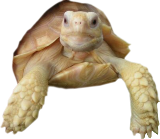
Riparian Farms

Care Sheet: Egyptian Tortoise
The Egyptian tortoise (Testudo kleinmanni) is a small North African Species. The males grow to about 4-inches and the females to about 5-inches. This tortoise comes from a mild subtropical climate. The Egyptian tortoise doesn't dig a burrow but digs a shallow pallet into soft earth or under bushes and debris to hide from the heat or cold. It is active on warm winter days and is more sensitive to cold than other species of Testudo. It is found in northeast Libya, northwest deserts of the Nile Delta, and the Sinai Desert of Egypt. It is listed as appendix I by CITES which restricts any international trade.
When you receive your tortoise it should be immediately soaked in shallow lukewarm water for about 15 minutes. Hatchling tortoises should be housed indoors. They can be put outside to receive natural sunlight, but should be watched and be able to get out of the sun when they get warm (if not they could become over heated and die). Adult tortoises can be kept outside during warm months when night temperatures are above 60 degrees and days are sunny.
Hatchling or adult tortoises can be maintained in a large glass aquarium, or a large plastic box such as a sweater box. The aquarium should be lighted with a good UL bulb and there should be a basking light on one side of the aquarium or box. The temperature at night should be above 70 degrees and days should be above 82 degrees. The tortoises require a basking light to elevate their body temperature to 85 to 90 degrees, which aid in digestion. I maintain my adult tortoises on a substrate of crushed oyster shell (available at most feed stores), or outside on suitable days.
For young tortoises I use a substrate of very slightly moist peat moss or coconut fiber which gradually transitions to dry peat moss, then dry alfalfa, and finally dry oyster shell. The section with moist peat moss is covered with a plastic lid from a shoebox. This provides a slightly moist area that the tortoise can dig into and hide. The tortoises are fed on the dry alfalfa. This added moisture seems to be beneficial to uniform shell growth.
The hatchlings must be fed very finally chopped food (very soft or thin greens), or moistened tortoise chow. As they grow begin to add other greens that they are able to bite pieces off and eat.
The Egyptian tortoise is a grazer and herbivores. They do not eat meat of any kind and require very little fruit. Adult tortoises can be maintained in yards where there are a variety of edible weeds, flowers, grasses or other plants. Adults can be fed dark green vegetables and commercial tortoise diets. Your tortoise should be soaked in a shallow tray of water once or twice a week. They should always have shade available so they can get out of direct sun when they have warmed up. A hide box or turtle house is recommended.
Hatchling tortoises should be fed daily. A diet of chopped greens (kale, endive, mustard, dandelions, etc.) and/or a commercial tortoise diet (about 15 percent protein dry weight) should be fed to the tortoises. They should be soaked in shallow lukewarm water at least every other day. If your tortoise is kept warm fed and watered regularly, and given adequate room it should live for years.